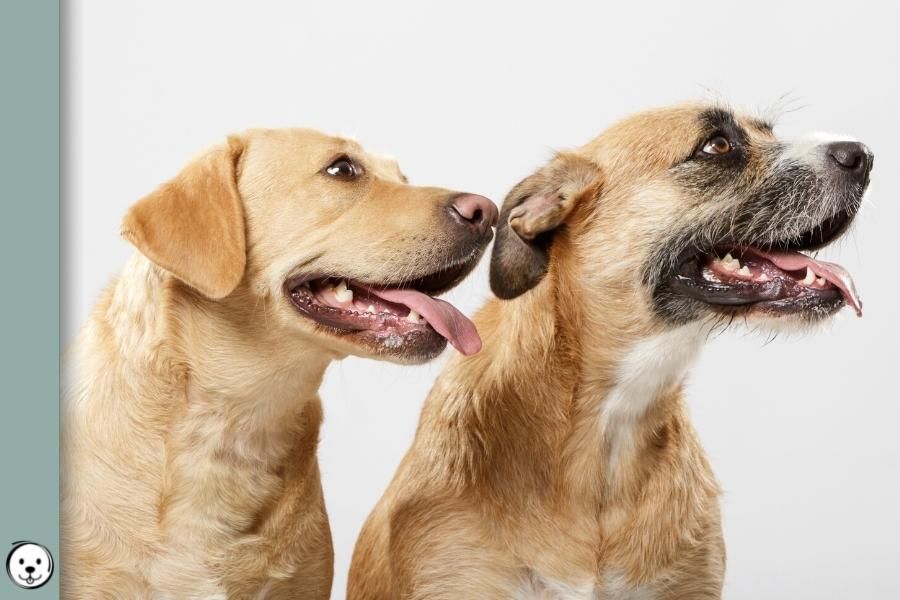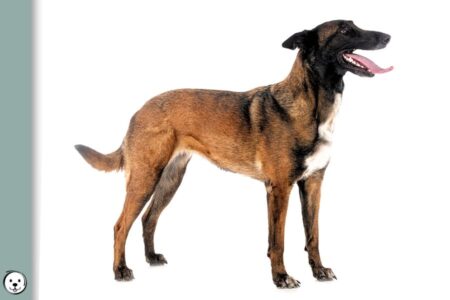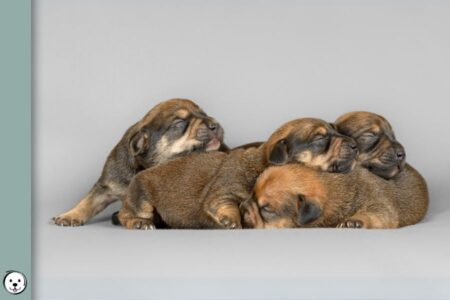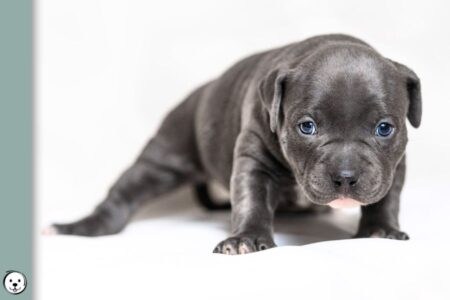Some breeds like Golden Retrievers and Labrador Retrievers or varieties like white Poodles or black German Shepherds produce only one type of pigment and have a single-colored coat.
But most dogs can produce both eumelanin and phaeomelanin and have banded hairs, yellow coats with darker hair tips or other patterns with areas of darker and lighter pigment.
Here you can learn what makes a pigment cell switch from one pigment type to the other and how the E-Locus, K-Locus and A-Locus interact to create different patterns.
But: This information is a bit technical and is helpful but in no way essential for grasping the concept of canine color inheritance. Feel free to skip this chapter or come back later.
Content
The E-Locus
Melanocytes are melanin-producing pigment cells found in the hair follicle.
Here they produce pheomelanin by default, unless they are told otherwise.
Phaeomelanin is a yellow-red pigment, but varying pigment density can produce different shades from off-white to yellow or even dark red.
Eumelanin is a black pigment, but can be modified to brown, blue, or lilac. Pigment cells are able to produce eumelanin but they need an external signal to actually do so.
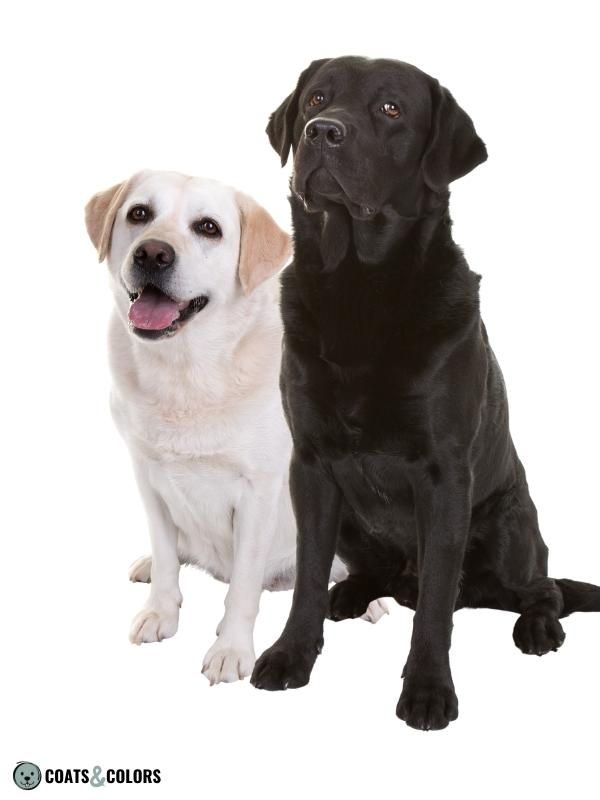
But how can the pigment cells be told what pigment type to make?
Here the E-Locus comes into play!
The Extension Locus or short E-Locus encodes the building plan for a receptor found in the membrane of melanocytes. This Melanocortin 1 Receptor or MC1R can be activated from the outside of the cell. If the right molecule comes along and binds to MC1R the pigment cell gets a signal to activate eumelanin production.
If all things work according to plan this happens when α-Melanocyte-stimulating hormone (α-MSH) is secreted by the pituitary gland and binds to MC1R.
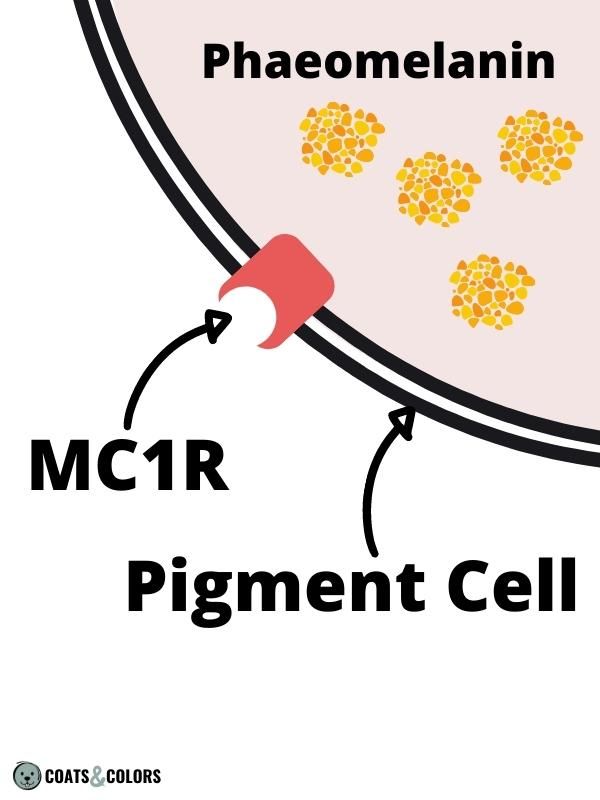
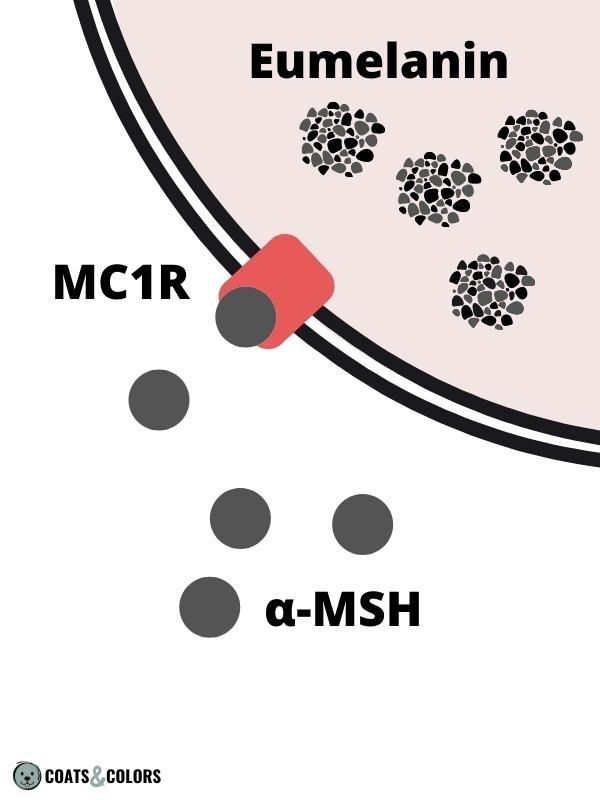
The various alleles on the E-Locus are building plans for some slightly different versions of the Melanocortin 1 Receptor:
- Em is the dominant allele in this series. It works normally but also produces a melanistic mask and is associated with a tendency for more shading in agouti and sable dogs.
- E is the wild-type allele and just enables normal pattern expression.
- eG, eA, eH are reduced-function alleles that cause a domino phenotype with bigger and lighter phaeomelanin markings and a reduced ability to produce eumelanin compared to non-domino dogs. Domino alleles can be described as partial recessive red since they reduce but not fully remove the functionality of MC1R.
- e is a loss-of-funtion mutation that basically deactivates the MC1 Receptor[2]. This causes a solid white, yellow or red phenotype in all pigmented areas.
If a dog inherits the recessive e allele from both parents he can not build a normally functioning MC1 Receptor. The pigment cells consequently remain forever locked in their default setting to only produce phaeomelanin.
This is why the genotype ee leads to an all-white, all yellow or all red phenotype and is called recessive red. Typical examples are Golden Retrievers, Irish Setters or Apricot Poodles.
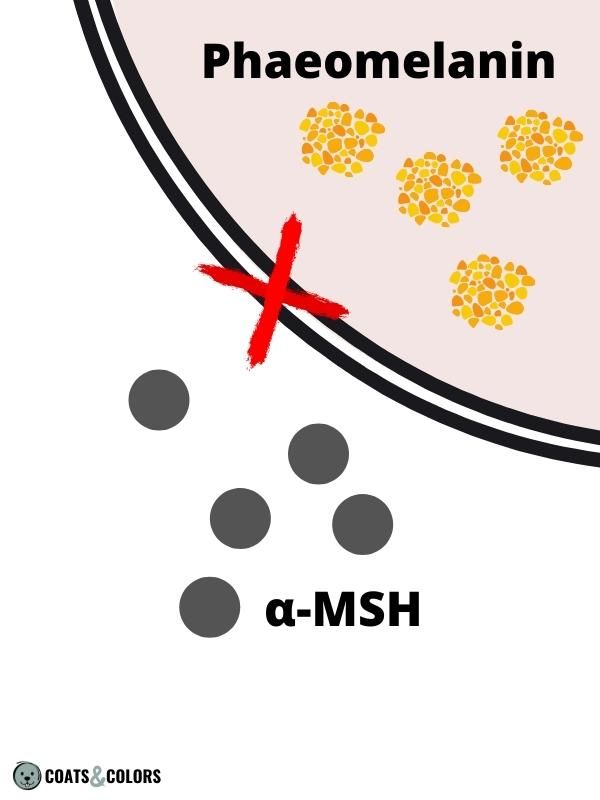
The A-Locus
At the Agouti Locus or short A-Locus lies the building plan for Agouti signaling Protein or ASIP.
ASIP wants to bind to the Melanocortin 1 Receptor, it functions as a competitive antagonist to α-MSH and blocks access to MC1R. So if ASIP is present α-MSH can’t bind to MC1R and can’t signal the cell to produce eumelanin. And without a signal from α-MSH the melanocytes produce phaeomelanin.

In any body part where ASIP is expressed the hairs might come out all yellowish since the cells primarily produce phaeomelanin. If ASIP is expressed in intervals the coat will be banded with darker and lighter stripes of pigment.
The different alleles on the A-Locus known up to now cause different patterns:
- Ay or sable is yellow coat with maybe some amount of darker hair tips.
- Ays or shaded sable is yellow coat with dark shading.
- aw is the agouti wild type and means a banded coat with darker and lighter stripes in every hair.
- asa is a saddle back phenotype with large tan markings and a black mantle.
- at causes tan points on specific areas of an otherwise black dog.
- a is a loss-of-funtion mutation that disables ASIP. It causes recessive black since α-MSH now has the competitive advantage and can bind to MC1R and activate the production of eumelanin.
If a dog inherits the recessive a allele from both parents he can not build a normally functioning Agouti Signaling Protein. The pigment cells can not be stopped from producing eumelanin.
This is why the genotype aa leads to an all-black (or brown, blue, isabella) phenotype and is called recessive black.
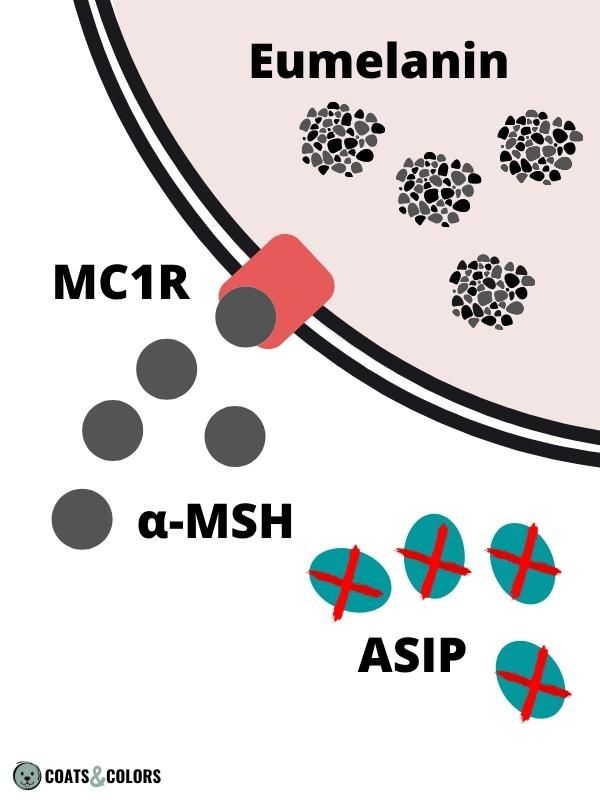
The K-Locus
The DEFB103 gene at the K-Locus encodes the building plan for β-Defensin 103 (CBD103). This protein normally is part of the innate immune response system of the skin.
In dogs there is a mutated version of the β-Defensin 103 known as KB allele.
KB is able to bind to the MC1 receptor where it promotes eumelanin production and blocks both ASIP and α-MSH from binding to MC1R[1].

KB masks the effect of ASIP so dogs with at least one KB allele cannot show whatever pattern they have at their A-Locus. Since affected dogs only produce eumelanin this phenotype is called dominant black.
Black and chocolate brown Labrador Retrievers or Poodles are examples of dominant black dogs.
We know of 3 gene variants at the K-Locus:
- KB is the dominant allele in this series ans causes an all black (or brown, blue, isabella) phenotype called dominant black.
- kbr seems to be an unstable intermediate form that causes a brindle pattern with dark stripes on tan coat.
- ky is the wild type and does not interfere with the normal pigment type switch function.
In some rarer phenotypes like seal or domino, the KB variant will not fully block phaeomelanin production.
Summary
The K-Locus and the A-Locus need a functioning Melanocortin 1 Receptor to work their magic.
An e/e genotype can mask whatever a dog has at his K-Locus or A-Locus. this makes the E-Locus epistatic to the other two loci.
The A-Locus does not affect coat color when KB is present. So the K-Locus has epistatic control over the A-Locus. Exemptions to this rule occur in seal or domino alleles at the E-Locus (eA, eG, eH).
Here you can find a quick overview of the outcome of all the possible combinations:
| E | K | A | Phenotype |
|---|---|---|---|
| Em/- | KB/- | – | Dominant Black |
| Em/- | kbr/- | Ay/- | Sable + Mask + Brindle |
| Em/- | kbr/- | Ays/- | Shaded Sable + Mask + Brindle |
| Em/- | kbr/- | aw/- | Agouti + Mask + Brindle |
| Em/- | kbr/- | at/- | Tan Point + Mask + Brindle |
| Em/- | kbr/- | asa/- | Saddle Pattern + Mask + Brindle |
| Em/- | kbr/- | a/a | Recessive Black |
| Em/- | ky/ky | Ay/- | Sable + Mask |
| Em/- | ky/ky | Ays/- | Shaded Sable + Mask |
| Em/- | ky/ky | aw/- | Agouti + Mask |
| Em/- | ky/ky | at/- | Tan Point + Mask |
| Em/- | ky/ky | asa/- | Saddle Pattern + Mask |
| Em/- | ky/ky | a/a | Recessive Black |
| E/- | KB/- | – | Dominant Black |
| E/- | kbr/- | Ay/- | Sable + Brindle |
| E/- | kbr/- | Ays/- | Shaded Sable + Brindle |
| E/- | kbr/- | aw/- | Agouti + Brindle |
| E/- | kbr/- | at/- | Brindlepoint |
| E/- | kbr/- | asa/- | Saddle Pattern + Brindle |
| E/- | kbr/- | a/a | Recessive Black |
| E/- | ky/ky | Ay/- | Sable |
| E/- | ky/ky | Ays/- | Shaded Sable |
| E/- | ky/ky | aw/- | Agouti |
| E/- | ky/ky | at/- | Tan Point |
| E/- | ky/ky | asa/- | Saddle Pattern |
| E/- | ky/ky | a/a | Recessive Black |
| eA/- eG/- eH/- | KB/- kbr/- ky/ky | Ay/- Ays/- aw/- asa/- at/- a/a | Various Domino Phenotypes |
| e/e | – | – | Recessive Red |
Learn More
Links
[1] Candille SI, Kaelin CB, Cattanach BM, Yu B, Thompson DA, et al. (2007) A beta-defensin mutation causes black coat color in domestic dogs. Science 11(1): 24–30. https://doi.org/10.1126/science.1147880
[2] Newton, J., Wilkie, A., He, L. et al. Melanocortin 1 receptor variation in the domestic dog. Incorporating Mouse Genome 11, 24–30 (2000). https://doi.org/10.1007/s003350010005
[3] Honkanen, L., Loechel, R., Davison, S., Donner, J., & Anderson, H. (2024). Canine coat color E locus updates: Identification of a new MC1R variant causing’sable’coat color in English Cocker Spaniels and a proposed update to the E locus dominance hierarchy. Animal Genetics. https://doi.org/10.1111/age.13398

Hi! I’m Steffi. I am a biologist and a big time dog nerd. You are curious about coat color genetics? You’ve come to the right place! Read more.

